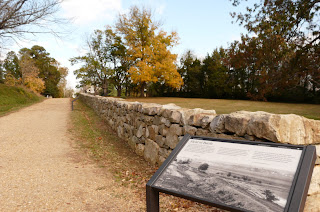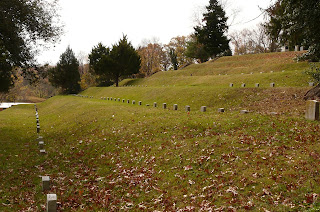I was well pleased with my planning. The drive from York Pa to Fredericksburg was an easy journey. TomTom was of great assistance.
Fredericksburg is close to a number of important Battle sites, and I was able to spend time in each of them. Today I will begin with the Battle of Fredericksburg.
The Battle itself began on December 11th, 1862. But the troops of both sides had been gathering there since November.
The Union troops were being led by Major General Ambrose Burnside. He had massed his army at Falmouth, not far from the Rappahanock River at Fredericksburg.
President Lincoln was desperate for a convincing defeat of the Confederate army, otherwise he was certain he would lose public support. The Confederates were doing much better that had been thought.
General Lee massed his army on the slopes of Prospect Hill and Maryes Heights. These slopes lay behind and above the town of Fredericksburg.
The first problem for Burnside was crossing the Rappanhanock. To do this he had to lay5 pontoon bridges. The soldiers given this task had no protective cover and were picked off easily by Confederate marksmen. But eventually, the bridges were in place, and Burnside's army crossed over the river on the 12th November, and the next day, the 13th, the Union troops launched a series of attacks on Prospect Hill and Maryes Heights. The Union troops could only make frontal attacks. The Confederates were above them and protected. Burnside had hoped that Lee or Jackson would have moved. But Lee knew how strong his position was.
After 3 days, Burnside reluctantly called of the attacks, his army having suffered massive staggering casualties.There had been one glimmer of hope when Meades soldiers briefy penetrated Jackson's line, but they were driven back down the hill in a counter-attack.
The Union Army suffered 12,653 casualties. 1284 men died, 9600 were wounded and 1769 were captured or missing.
The Confederates suffered 5377 casualties. 608 men died, 4116 men were wounded and 653 were captured or missing, most of them on in the early fighting on Stonewall Jackson's line.
While the Southern press gloried in the Victory, Lincoln and the Union Army were heavily criticised by the Northern Press.
It was sobering to wander round these fields and locations, some still easily identifiable from pictures of the day, and meditate on the futility of war, a lesson we never seem to learn. But if there is a bully, what do you do? Lie down to him, or fight for what you believe to be the truth?
There will be a re-enaction of the crossing of the Rappahanock in December this year. How I wish I could be there!
http://en.wikipedia.org/wiki/Battle_of_Fredericksburg
http://www.civilwar.org/battlefields/fredericksburg.html?gclid=CLn6_aGD47MCFXDLtAoddEEASw
http://www.civilwar.org/battlefields/fredericksburg/maps/fredericksburg-animated-map/
http://www.nps.gov/frsp/fredhist.htm
http://fredericksburg150.org/
 |
| confederate squirrlel |
 |
| car park with sunken road and wall in view |
 |
| Fredericksburg Battlefield Museum |
 |
| Fredericksburg after the Battle |
 |
| sunken road and wall |
 |
| Brompton House survived the Battle |
 |
| battle damage on cemetary gates |
 |
| so many dead, known, unknown |
 |
| Maryes heights |

































No comments:
Post a Comment